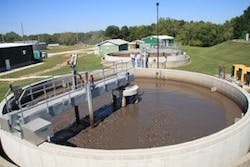Energy-Efficient Digesters Help Offset Power Cost Increases
Plant A, a water reclamation plant, had experienced an 85% increase in its power rates and began evaluating the energy efficiency of every piece of equipment in its facility.
Fortunately, the plant operates in a very energy-efficient manner. In 2006, the city built and started up a new water reclamation plant, replacing a 40-year-old two-phased trickling filter facility. The process configuration of the new plant consists of two countercurrent aeration reactors, two rapid-removal helical scraper clarifiers and two countercurrent aeration digesters, all supplied by Schreiber.
When it comes to energy efficiency, the Schreiber digesters perform well. Plant A operates two 200,000-gallon digesters, and the mixing for each of these units is supplied by only one 2-hp motor for each basin. Plant A’s staff had become increasingly curious about how much of the plant’s energy efficiency could be attributed to these “energy-miser” digesters. The staff decided that they might be able to get a handle on the digesters’ energy usage by employing a “comparative facility” approach to the issue using a sister facility—Plant B.
The wastewater treatment facility at Plant B is very similar to that of Plant A in terms of equipment type and size. In fact, the equipment components installed at the two plants are identical, except for their digesters, which are of a different type and brand. The Plant A and Plant B digesters also experience similar solids loading characteristics. Plant B digesters usually experience solids of around 4%, while Plant A typically maintains a solids content of about 4.5%. Also, both plants experience occasional excursions of up to a maximum of 6% solids.
Although Plant B was rated as a 3-mgd plant and Plant A was designed for a 2.4-mgd load, the two facilities were each handling an average load of around 1.5 mgd—Plant B at 1.6 and Plant A at 1.4.
When the power usage numbers for the two plants were compared over a 12-month period, it was found that Plant B consumed, on a monthly basis, roughly 102,000 kWh per mgd of influent, compared with Plant A’s 51,000 kWh per mgd per month. The resulting difference in the average monthly power usage should be attributed to the difference in digesters, since the two plants are otherwise very comparable.
Plant B’s digesters use three 80-hp blowers for a total of 240 hp for mixing and aeration. Since one of the three blowers is always in standby mode, the operating horsepower is limited to 160 hp (i.e. one 80 hp blower for each basin), which consumes about 65,000 kWh on a monthly basis, or about 0.09 kWh per gallon per month.
In contrast, Plant A digesters employ separate means for mixing and aeration components. The mixing device is a peripheral drive bridge with suspended racks of diffusers, which are used as aeration if necessary. They have a 2-hp motor on each digester that is used exclusively for mixing. These small motors run 24/7 to insure adequate mixing and consume about 2,200 kWh per month for mixing. The design is very similar to the Schreiber’s continuously sequencing reactor.
For digester aeration, the facility has three 30-hp blowers—one for each basin and one in reserve. However, since mixing is accomplished via the 2-hp motors, staff only needs to run the large aeration blowers intermittently to maintain the target dissolved oxygen (DO) levels of 0.5 to 1.5 mg/L in the digesters. The blowers only operate when the DO drops below the target level, so they typically are only on for a total of 12 hours per 24-hour period, which consumes an average of roughly 16,300 kWh per month. Together, digester mixing and aeration power consumption is roughly 18,500 kWh per month, or approximately 0.05 kWh per gallon per month.
Based on this comparative facility approach, the Schreiber digesters at Plant A require 44% less power than the digesters at the neighboring Plant B facility. The 46,500-kWh difference in monthly power use by the digesters accounts for approximately 91% of the difference in the monthly power usage between the two plants.
At the time of this test, the facility was receiving a little over half of the original design load and consuming about 20% less power than originally projected for this level of loading. Consequently, as the plant reaches design conditions, the system will save Plant A’s city approximately $30,000 per year in power bills due to its digesters. Interestingly, the two Schreiber digesters were originally clarifiers that served the old trickling filter plant. They were converted into digesters when the city built the new plant in 2006, which saved a considerable amount in construction costs.
